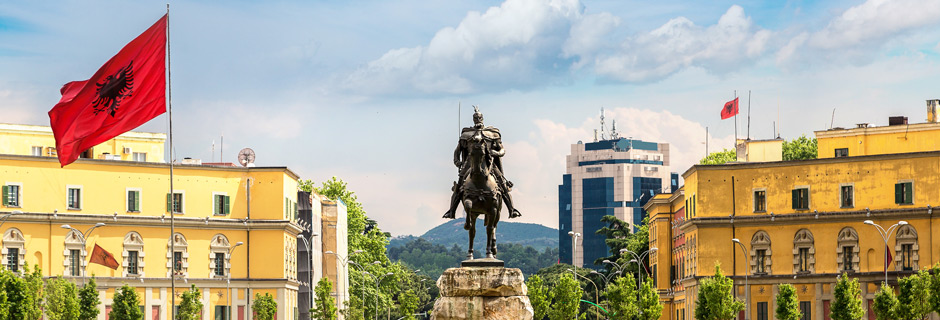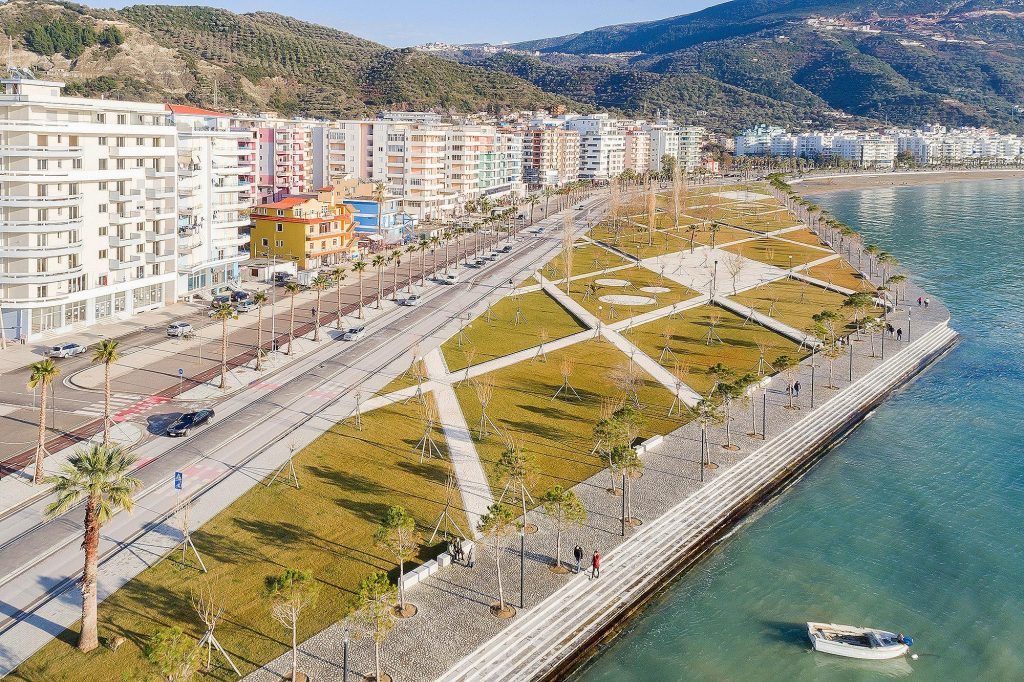TIRANA

Tirana has been the capital of Albania since 1920. It is relatively new city established in 1614 from Sulejman Bargjini, feudal of the area at the time. The city began to grow at the beginning of the 18th century. Today Tirana is not only the most populated city in Albania, but also the biggest political and economic centre in the country. In central Tirana, on Scanderbeg square there is the old mosque of Ethem Bey built during 1789 – 1823 as well as the Clock Tower, 35 meter high, built in 1830. The Palace of Culture housing the Opera and Ballet Theatre and National Library is next to the main square. In Tirana there are also other important institutions such as the National Historic Museum, Archaeological Museum, The Museum of Natural Sciences, the Museum of Albanian Philately, the National Gallery of Fine Arts, the Center of International Culture etc.
One can enjoy the best view from the “Martyrs Cemetery” which contains the “Mother Albania“ monument. The Adriatic sea and Dajti mountain are near to the city. It takes you less than one hour drive to reach the sea. A Great Park with an artificial lake is located immediately at the southern part of the city.
View all properties for rent or sale in Tirana by clicking here: https://www.realestate.al/en/properties-in-Tirana
- What to see
The Fortress of Pertrela It is located at south of Tirana on the right side of national road linking capital with the city of Elbasan. It was built up by the middle age. The castle was under the command of Scanderbeg sister, Mamica Kastrioti.
The fortress of Preza, belongs to the XV century. It has a very nice and dominant position in front of Kruja mountain.
The Mosque of Ethem Bey is situated just at the center of Tirana. It was constructed in 1789. Together with the Clock Tower ( 1830). they make a important historic part of Tirana.
Ministries represents architectonic values. They were built in the year 1930, when Albania was a kingdom.
After the Second World War several buildings were erected. The Palace of Culture, the Palace of Congresses, the National Historic Museum, the Centre of International Culture etc.
The bridge of Tabakeve is situated along the boulevard “Zhan Dark”. It belongs to the XVIII century.
The Tomb of Kapllan Pasha, built in 1814.
- Museums
The Museum of National History (phone +355 223446 / 228389 )
Archaeological Museum
Gallery of Fine Arts (closed at Mondays)
Museum of Albanian Philately
The Museum of Natural Sciences
VLORA
Vlora is a coastal city. It is not only one of the major ports, but also of great historical importance as it was here that in 1912 the Assembly was convened to proclaim Albania as an independent state and to set up the first National Government headed by Ismail Qemali. One can learn more about the background of this event at the Museum of Independence. On a hill above the city one can enjoy the religious place of “Kuzum Baba”. From there you can see the beach and the view of the whole city.
View all properties for rent or sale in Vlora by clicking here: https://www.realestate.al/en/properties-in-Vlora
- What to see
Ethnographic Museum (open 08.00–12.00 and 16.00–18.00 )
Historic Museum (open 8.00–12.00 and 16.00– 18.00)
The Museum of Independence (open 8.00–12.00 and 16.00–18.00)
The Mosque of Muradie
The Castle of Kanina, in Kanina village
The Castle of Porto-Palermo
The ruins of Himara Castle, Himare
Churches of Saint Stephen and Saint Mitri in the village of Dhermi ( XII –XIV centuries)
Monastery of Saint Mary, in Zvernec Village
Ancient theatre of Orikum (First century B.C)
The Church of Marmiroi in Orikum
Fieri
Between Tirana and Vlora there is the district of Fier, which boasts different historical sites with great interest . The most important are:
Historic Museum in Fier
Archaeological Museum of Apollonia, in village of Pojan
Monastery of Saint Mary at Apolonia,
Archaeological site of Apolonia
Archaeological site of Bylis, in Hekal village
The ruins of the Church of Saint Mary, in Ballsh
View all properties for rent or sale in Fier by clicking here: https://www.realestate.al/en/properties-in-Fier
BERAT
It known as “the city of one-thousand windows” and is declared as a museum city. It is on the slopes of the Tomorri mount where the castle of the city rises in a predominant hill. Inside its walls there are dwelling houses and the “Onufri Museum”. Paintings and icons by the outstanding Albanian painter are also exhibited there. The old part of the city has some religious buildings like churches and mosques.
- What to see
The Museum of Iconography “Onufri” (open 8.00-15.00, closed at Mondays, phone +355 32 32 248).
The Museum of Ethnography (open 8.00-15.00, phone +355 32 32224)
Gallery “Eduard Lear” (open for each day, phone +355 32 32 027)
The castle of Berat
The Church of Saint Mehilli, (Michael)
The Cathedral of Saint Mary,
The Church of Saint Triadha (Trinity),
The Church of Saint Vllaherna
The King Mosque
The Bridge of Gorica, over river Osum
DURRES
The principal port of Durres is the second largest city of Albania. The city was colonized by the colonists from Corinth and Korkyra in 627 B.C. It was named Epidamnus, which later became Dyrrachium. The most important object is the amphitheatre, the largest in Balkan with 15,000 seats, dating back to the 2nd century AD and containing an Early Christian crypt with a rare wall mosaics . Between the 1st and 3rd centuries Durres was an important port and trading centre on the Via Egnatia trading route, between Rome and Byzantuim (Istanbul). After a great number of earthquakes, much of ancient Durres sank into the sea or collapsed and was subsequently built over. Today the city is well known for the nearby beach resort of Durres and its sandy beaches and warm sea waters.
View all properties for rent or sale in Durres by clicking here: https://www.realestate.al/en/properties-in-Durres
- What to see
The Archaeological Museum (open 9- 17.00, closed each Monday and Tuesday, phone +355 52/22253)
Amphitheatre
Byzantine Forum
Venetian Torra (small castle open as a bar)
Ancient city wall
The Exhibition of Folk Culture (open 8.00-13.00 for each day)
The mosaic of Arapaj, Arapaj village (it can be opened only with special permit)
KRUJA
Kruja is a medieval town near Tirana. It is on built on the slope of Sari Salltiku mount. The name of Kruja is closely connected with the name of the National Hero, George Kastriot Scanderbeg, who fought against the Ottomans for 25 years in succession, defending European civilization from their threat in the 15th century. At a prominent and strategic place near the city, there is a castle, within is housed the Scanderbeg Museum (National Museum). On the way to the castle there is a medieval bazaar.
- What to see
Museum of Gjergj Kastrioti Scanderbeg (open 09.00- 13.00 and 15.00-8.00, closed at Mondays, phone + 355 532 2225)
Ethnographic Museum (open 09.00-13.00 and 15.00 -18.00 closed at Mondays)
Archaeological site of Albanopoli, in village of Zgerdhesh
Traditional Bazaar
KORCA
Is the largest city of south eastern part of Albania. It is situated at the foot of Morava Mountain on a plateau 800 m above sea level. It became an important trading and handicraft centre in the 18th century due to the development of trade with neighboring regions. The museum for Medieval Art is in Korça. It presents the spiritual and material culture of the Albanian people. There are also the Museum of Education, where the first Albanian School were opened in 1878 and the new museum of “Bratko Collections” with antiquaries from the Far East.
- What to see
The Museum of Medieval Arts, (open 8.00 – 14.00) .
The Gallery “ Guri Madhi”, (open 10.00 – 12.00 and 16.00- 18.00)
The “Bratko” Museum of antiquaries and collections from far east, (open 9.00- 12.00 and 16.00- 18.00)
The Museum of Education, (open 8.00 – 14.00)
The Archaeological Museum, (open 8.00 – 14.00)
Watering greensward (a suite place for emigrants, where young ladies use to shed tears)
POGRADEC
Pogradec is one of the most charming tourist resorts in Albania because of its position on lake Ohrid which distinguishes itself for clear water and mountain views. The koran fish, similar to trout, is found in this lake. Besides the beautiful beach, your stay in Pogradec is made more interesting by the excursion to the tourist centre in Driloni (5 km eastward) surrounded by ornamental plants and trees.
- What to see
The mosaics of Lin, in the village of Lin at north of Pogradec
The sources of Drilon
The monumental graves of Selca e Poshtme, in village of Selca
The Goliku Bridge on the old Via Egnatia
GJIROKASTRA
One of the most important cities of southern Albania, has been declared a “Museum City”. It is built on the slope of a mountain and is known for its characteristic and narrow stone paved streets. The dwelling houses have the form of medieval towers consisting a building ensemble with characteristic architecture. The castle of the city stands like a balcony over the city. It enables the visitors to enjoy a very beautiful landscape. The National Museum of Weapons is housed in the interior of the castle. Weapons are produced and used by the Albanian since the ancient times are displayed there.
What to see
The Museum of Weapons (inside the castle)
The Ethnographic Museum (phone +355 846 2460)
The Castle of Gjirokastra
The Church of Labova e Kryqit, in the village with same name
The archaeological site of Antigonea, in the village of Saraqinisht
The ruins of archaeological site of Adrianapol, in the village of Sofratike
SARANDA
Albania’s most southern city. Situated opposite of Corfu island, Saranda is now mostly visited by day trippers who come to enjoy this previously inaccessible resort. It is one of the most tourist sites in Albania and is very preferable by “honey mooners”. Near Saranda there are the ruins of the ancient city of Butrint and the Springs of “Blue Eyes”.
View all properties for rent or sale in Saranda by clicking here: https://www.realestate.al/en/properties-in-Saranda
- What to see
Ethnographic Museum
The Archaeological Museum of Butrinti
The ruins of ancient town of Onhezmi in Saranda
The ancient temple and other ruins of Foinike, in Finiq village
The small Castle of Ali Pasha in Vrine village
Archaeological site of Butrinti
The Church of Saint Kolli in Mesopotam village
SHKODRA
It is one of the most major cities in the north – western part of the country. It is situated near the lake sharing the same name and along the road that leads to Montenegro. It is an ancient city with rich history. One can find old characteristic houses where wood and other traditional motifs are used. Near the city there is the castle of Rozafa built on a rocky hill from where you can see attractive and beautiful views. During your stay you can visit the Historical Museum of the city. Shkodra is a good point to start your trip to Albanian Apls.


